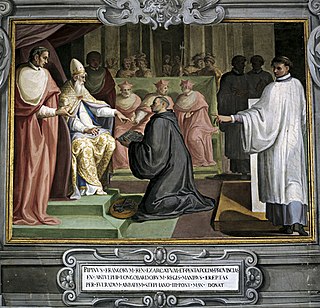This article needs additional citations for verification .(February 2017) |
The Roman Catholic Archdiocese of Naples (Latin : Archidioecesis Neapolitana) is a Roman Catholic archdioceses in southern Italy, the see being in Naples. A Christian community was founded there in the 1st century AD and the diocese of Naples was raised to the level of an Archdiocese in the 10th century. [1] Two of Archbishops of Naples have been elected Pope, Paul IV and Innocent XII. [2] [3]
| Bishops of Naples | |||
|---|---|---|---|
| Name | Years | ||
| Asprenas | |||
| Epithymetus | |||
| Maro | |||
| Probus | |||
| Paulus I | |||
| Agrippinus | |||
| Eustathius | |||
| Ephebus (Euphebius) | |||
| Calepodius | attested 343 | ||
| St Fortunatus I | attested 344 | ||
| Maximus | banned 356 | ||
| Zosimus | c. 356 – c. 362 | ||
| Severus | c. 362 – c. 408 | ||
| Ursus | |||
| John I | † 432 | ||
| Nostrianus | 432 – after 452 | ||
| Timasius | |||
| Felix | |||
| Soter | attested 465 | ||
| Victor I | c. 492/6 | ||
| Stephen I | c. 499/501 | ||
| Pomponius | |||
| John II Mediocris | |||
| Vincent | 554 – 578 | ||
| Redux | 581 – ? | ||
| Demetrius | ? – 591 | ||
| Fortunatus II | 593 – 600 | ||
| Paschasius | 600 – ? | ||
| John III | |||
| Caesarius | |||
| Gratiosus | |||
| Eusebius | |||
| Leontius | attested 649 | ||
| Adeodatus | |||
| Agnellus | attested 680 | ||
| Julianus | ? – 701 | ||
| Laurentius | 701 – 717/8 | ||
| Sergius I | 717/8 – ? | ||
| Cosmas | |||
| Calvus | 750 – 763 | ||
| Paul II | 763 – 768 | ||
| Stephen II | 767/8 – 799/800 | ||
| Paul III | c. 800 – 821 | ||
| Tiberius | 821 – 841 | ||
| John IV | c. 842 – 849 | ||
| Athanasius I | 849 – 872 | ||
| Athanasius II | 876 (875?) – 898 | ||
| Stephen III | 898 – ? | ||
| Athanasius III | 937 – ? | ||
| Nicetas | 962 – ? | ||
| Gregory I | 966 – ? | ||
| Archbishops of Naples | |||
| Sergius II | 1005–1033 | ||
| John V | 1033–1045 | ||
| Victor II | 1045–1059 | ||
| Sergius III | 1059–1071 | ||
| John VI | 1071–1080 | ||
| Landulf | 1080–1094 | ||
| Peter I | 1094–1100 | ||
| Gregory II | 1116–1118 | ||
| Marinus | 1118–1151 | ||
| Sergius IV | 1176–1190 | ||
| Anselm | 1191–1214 | ||
| Thomas of Capua | 1215–1216 | ||
| Peter II of Sorrento | 1217–1247 | ||
| Bernadino Caracciolo dei Rossi | 1252–1262 | ||
| Delfino | 1262–1266 | ||
| Aiglerio de Borgogna | 1266–1281 | ||
| Filippo Minutolo | 1288–1301 | ||
| Beato Giacomo da Viterbo | 1302–1307 | ||
| Uberto d'Ormont | 1308–1320 | ||
| Matteo Filomarino | 1322–1323 | ||
| Bertoldo Orsini | 1323–1326 | ||
| Annibale di Ceccano | 1326–1328 | ||
| Giovanni Orsini | 1328–1359 | ||
| Bertrando de Meyshones | 1359–1363 | ||
| Pietro de Grazia | 1363–1365 | ||
| Bernardo de Bouquet | 1365–1368 | ||
| Bernardo de Rhodez | 1368–1379 | ||
| Tommaso de Ammanati | 1379–1388 | ||
| Ludovico Bozzuto | 1378–1384 | ||
| Nicola Zanasio | 1384–1389 | ||
| Guglielmo Guindazzo | 1388–1399 | ||
| Enrico Capece Minutolo | 1389 | ||
| Nicola Pagano | 1399–1401 | ||
| Giordano Orsini | 1401–1405 | ||
| Giovanni Bozzutto | 1407–1415 | ||
| Giacomo dei Rossi | 1418–1435 | ||
| Nicola de Diano | 1418–1435 | ||
| Gaspare de Diano | 1438–1451 | ||
| Rinaldo Piscicello | 1451–1457 | ||
| Oliviero Carafa | 1458–1484 | ||
| Alessandro Carafa | 1484–1505 | ||
| Vincenzo Carafa | 1505–1530 | ||
| Francesco Carafa | 1530–1544 | ||
| Rainuccio Farnese | 1544–1549 | ||
| Gian Pietro Carafa | 1549–1555 | ||
| Alfonso Carafa | 1557–1565 | ||
| Mario Carafa | 1565–1576 | ||
| Beato Paolo Burali d'Arezzo, C.R. | 1576–1578 | ||
| Annibale di Capua | 1578–1595 | ||
| Alfonso Gesualdo di Conza (Gonza) | 1596–1603 | ||
| Ottavio Acquaviva d'Aragona (seniore) | 1605–1612 | ||
| Decio Carafa | 1613–1626 | ||
| Francesco Boncompagni | 1626–1641 | ||
| Ascanio Filomarino | 1641–1666 | ||
| Innico Caracciolo | 1667–1685 | ||
| Antonio Pignatelli | 1686–1691 | ||
| Giacomo Cantelmo | 1691–1702 | ||
| Francesco Pignatelli | 1703–1734 | ||
| Giuseppe Spinelli | 1734–1754 | ||
| Giuseppe Maria Capece Zurlo | 1802–1832 | ||
| Luigi Ruffo-Scilla | 1802–1832 | ||
| Filippo Giudice Caracciolo | 1833–1844 | ||
| Sisto Riario Sforza | 1845–1877 | ||
| Guglielmo Sanfelice d'Acquavilla | 1878–1897 | ||
| Giuseppe Antonio Ermenegildo Prisco | 1898–1923 | ||
| Michele Zezza di Zapponeta | 1923–1923 | ||
| Alessio Ascalesi, C.PP.S. | 1924–1952 | ||
| Marcello Mimmi | 1952–1958 | ||
| Alfonso Castaldo | 1958–1966 | ||
| Corrado Ursi | 1966–1987 | ||
| Michele Giordano | 1987–2006 | ||
| Crescenzio Sepe | 2006-2020 | ||
| Domenico Battaglia | incumbent | ||













